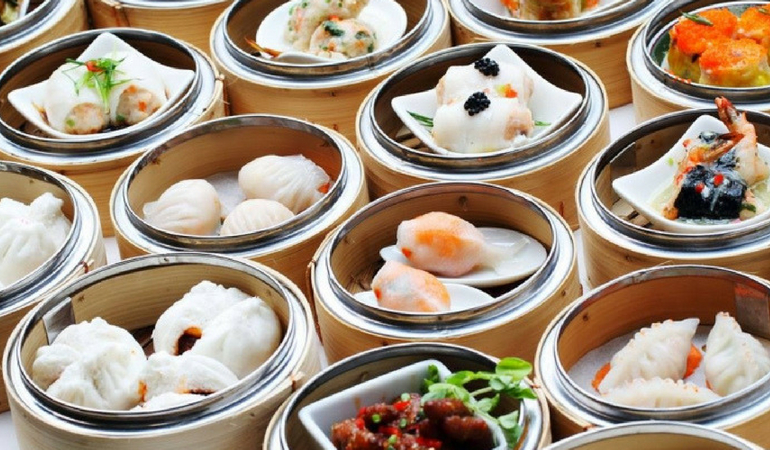
What is Dim Sum?
Dim sum is a Chinese meal of small plates best enjoyed with tea in the company of family and friends.
Though dim sum can be found in many forms and in all regions of China, the cuisine is most closely associated with the teahouse culture of Hong Kong and Guangdong Province. Hundreds of years ago, travelers along the famous Silk Road and weary rural farmers would frequent local teahouses (the Cantonese cha lau) for rest and conversation accompanied by a cup of tea. When the teahouses began serving food with a patron’s tea, the seeds for today’s modern dim sum tradition were planted.
The first, early 20th century incarnations of dim sum dishes were larger, starchier dumplings intended for the blue collar appetites of day laborers who needed a quick, hearty meal during the day. While examples of these traditional dishes can still be found in old Hong Kong dim sum parlors like Lin Heung, contemporary restaurants today often produce a dizzying array of 100+ lighter dishes during a typical meal service ranging from the steamed chicken feet known as fong djau to the taro root dumplings known as wu gohk.
Dim sum is literally translated to mean “touch the heart” and the associated Cantonese phrase yum cha means “to drink tea.” Taken together, dim sum is a meal of small dishes served with tea comprised of a collection of savory and sweet tastes from a variety of steamed and fried buns, dumplings and rolls. Though the best kitchens are still found in Hong Kong and Guangzhou, dim sum is now served around the world and the cuisine remains one of southern China’s most famous culinary exports.
How to Order Dim Sum
Dim sum can be found everywhere from humble Chinatown takeaway storefronts to glittering restaurant palaces serving hundreds of diners at a time. Though dim sum is typically a mid-day meal, some restaurants open as early as 5AM for an older clientele who may quietly eat while dwelling over the morning paper with a cup of tea. Once the crowds swell later in the day, the pace and volume heighten as patrons order from checklist menus or from steam carts pushed by attendants around the restaurant floor.
Dim sum meals begin by selecting a tea for the table. Jasmine, Oolong, Chrysanthemum, Sau Mei (a white tea) and Bo Lei (a black tea) are most common and refills are obtained by propping the lid on top of an empty teapot. As the meal begins, survey the scene and observe what is available on the push carts and what other tables are having. Plates of dim sum are typically classified as small, medium or large with most costing no more than a few dollars apiece.
A typical dim sum meal includes several kinds of steamed buns like char siu bao (roast pork buns), deep fried dumplings like hahm sui gohk (glutinous rice dumplings), rice noodle rolls like ngau cheung (beef noodle rolls) and desserts like djeen dui (fried sesame balls). Food is usually served three- or four-servings to a portion and arrives in bamboo steamers or on small plates. For the best experience, arrive on the weekend before church lets out to avoid the crowds, secure a table near the kitchen to have first choice of the most freshly-prepared dishes and pace yourself to insure that you enjoy a wide variety of food.
How to Make Dim Sum
Preparing dim sum can be labor intensive and complicated, demanding that professional and home chefs alike practice numerous techniques to produce the diversity of wrappers and fillings found in a complete meal. Indeed, master Hong Kong chefs may spend decades before finishing their training. At home, it may be best to start by cooking two or three dishes sharing a common filling, complemented with a larger rice or noodle dish.
Dim sum preparation requires six basic stations or skills: a) preparation; b) rice noodle rolls, steamed and filled with meats; c) steaming; d) deep frying; e) fillings; and, f) dumpling making, wrapping the various fillings in dough. In a traditional restaurant dim sum kitchen, chefs operate in teams and trainees only advance after mastering a particular function completely.
The standard point of comparison for many dim sum chefs (and, as a result, many diners in dim sum restaurants) is the shrimp dumpling known as har gow. These shrimp dumplings are notoriously difficult to make because their skins are formed from a sticky rice flour dough that breaks apart easily. The next time you are out at a dim sum restaurant, count the pleats along the outer edge of a har gow – twelve or more denotes the handiwork of a master chef.
Enjoy delicious dim sum!
HT: Photo by More Than Shipping.